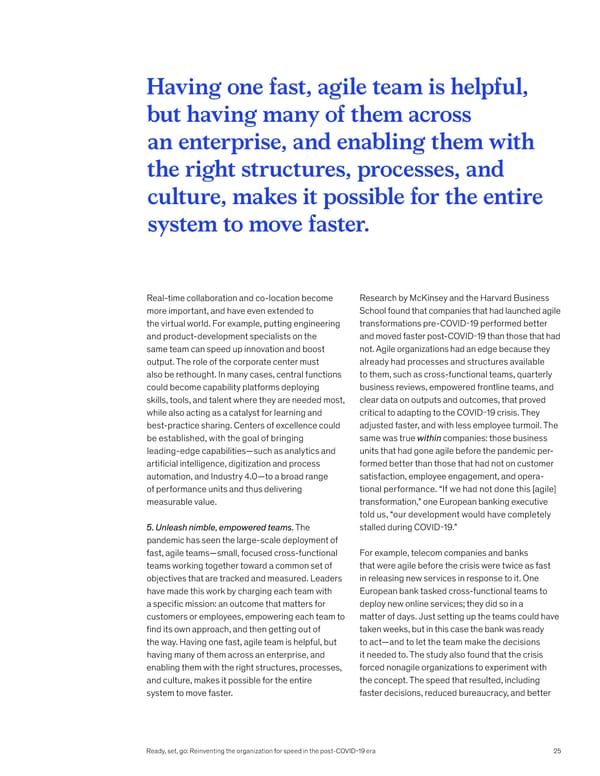Having one fast, agile team is helpful, but having many of them across an enterprise, and enabling them with the right structures, processes, and culture, makes it possible for the entire system to move faster. Real-time collaboration and co-location become Research by McKinsey and the Harvard Business more important, and have even extended to School found that companies that had launched agile the virtual world. For example, putting engineering transformations pre-COVID-19 performed better and product-development specialists on the and moved faster post-COVID-19 than those that had same team can speed up innovation and boost not. Agile organizations had an edge because they output. The role of the corporate center must already had processes and structures available also be rethought. In many cases, central functions to them, such as cross-functional teams, quarterly could become capability platforms deploying business reviews, empowered frontline teams, and skills, tools, and talent where they are needed most, clear data on outputs and outcomes, that proved while also acting as a catalyst for learning and critical to adapting to the COVID-19 crisis. They best-practice sharing. Centers of excellence could adjusted faster, and with less employee turmoil. The be established, with the goal of bringing same was true within companies: those business leading-edge capabilities—such as analytics and units that had gone agile before the pandemic per- artificial intelligence, digitization and process formed better than those that had not on customer automation, and Industry 4.0—to a broad range satisfaction, employee engagement, and opera- of performance units and thus delivering tional performance. “If we had not done this [agile] measurable value. transformation,” one European banking executive told us, “our development would have completely 5. Unleash nimble, empowered teams. The stalled during COVID-19.” pandemic has seen the large-scale deployment of fast, agile teams—small, focused cross-functional For example, telecom companies and banks teams working together toward a common set of that were agile before the crisis were twice as fast objec tives that are tracked and measured. Leaders in releasing new services in response to it. One have made this work by charging each team with European bank tasked cross-functional teams to a specific mission: an outcome that matters for deploy new online services; they did so in a customers or employees, empowering each team to matter of days. Just setting up the teams could have find its own approach, and then getting out of taken weeks, but in this case the bank was ready the way. Having one fast, agile team is helpful, but to act—and to let the team make the decisions having many of them across an enterprise, and it needed to. The study also found that the crisis enabling them with the right structures, processes, forced nonagile organizations to experiment with and culture, makes it possible for the entire the concept. The speed that resulted, including system to move faster. faster decisions, reduced bureaucracy, and better Ready, set, go: Reinventing the organization for speed in the post-COVID-19 era 25
 What Now? Page 26 Page 28
What Now? Page 26 Page 28